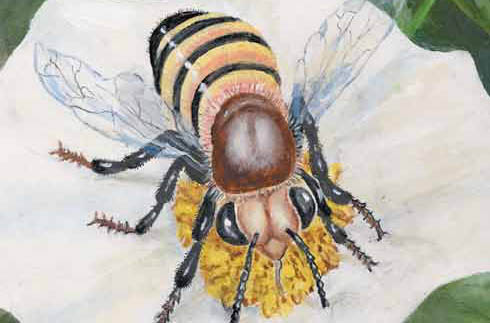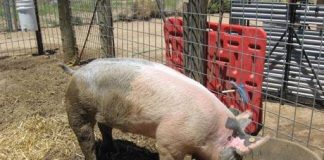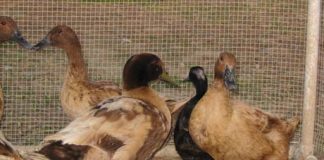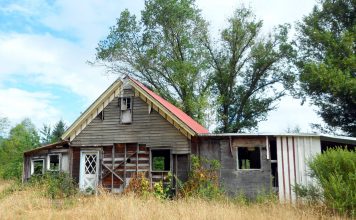 |
 |
| Issue #88 • July/August, 2004 |
Bees have been managed for their honey production for about 5000 years or so. Especially for the smallholder, beekeeping can be an interesting and rewarding pursuit. They are not labor intensive and don’t take up much space. To top it off, the rewards are sweet, literally.
The honey that an average colony will produce in a year is usually enough for a family to use with enough left over to sell some as well. The market for good wildflower honey is always good, and selling or bartering your surplus can be a welcome shot in the arm to the homestead economy. Even after a fairly hard winter and an average summer, I have had a colony of bees produce a surplus of honey with a total extracted weight of 110 pounds. That was much more sweetener than we use in a year, so we were able to realize a little extra income from the surplus.
|
The hive
To get started, you will need some basic equipment for the hive itself. You will need and want to add items as you become more familiar with beekeeping. To help you, take a look at the accompanying glossary and become familiar with the basic parts of the beehive and some of the beekeeper’s terminology.
Next, you will need to obtain the basic parts of the hive as depicted in the illustrations. This is best done initially by purchasing the pieces you need. Nearly all of the bee equipment suppliers offer beginner’s packages that have just about everything you’ll need. Check out some of the sources listed at the end of this article and get their catalogs. You may also be fortunate enough to locate and purchase working colonies of bees from an established beekeeper.
Once you have your hive hardware, you will need to get it situated. You will need to have the hives elevated somewhat, as shown in the accompanying illustration, and not just resting on the ground. You can set them on some concrete blocks, a wooden stand made especially for the purpose, or another structure that will get them up out of the grass.
The illustration depicts the basic make up of a typical beehive. Most texts describe the use of shallow honey supers (see the glossary) atop the deep hive bodies, but I use the same size deep supers or hive bodies throughout. The deep super and hive body are the same size; the only difference is in their name, being given for their particular use on the hive. The reason I like using the deep supers is that I have to purchase only one size of foundation and I can make or purchase the boxes all the same size as well. The main drawback to using deep supers is that they can weigh up to 100 pounds when full. However, there is less handling, overall, than when using shallow supers and the bees work the deep supers well.
Another trick is to use only 9 frames in the standard 10-frame super. By evenly spacing the frames in the super, the bees will naturally draw the comb out further. This will put the cappings up higher above the edge of the frame and help to make the uncapping chore much easier. (More on this later.) You can easily make or purchase a spacer to help to insure getting the correct spacing on the frames in the super although spacing them by hand in just a few colonies is not a difficult chore.
|
Speaking of frames, these very essential and basic pieces of equipment are the heart of the home apiary. They allow quick and easy access for examining the bees and for removal of honey. They will need to be set up with wired foundation. These are sheets of beeswax with two important features: first, they have embedded wires that help to support the comb and prevent it from tearing when extracting honey. Second, it is embossed with the exact shape of the honeycomb that will be drawn out on it. The result is nice, uniform combs.
Where do I get my bees?
Once you have the basic hardware in place, you need to acquire your winged livestock for the hive. Probably the best way for beginning beekeepers to get bees is to purchase them from a commercial supplier. Some of the beekeeping suppliers listed at the end of this article offer bees for sale. Your honeybees will be mailed to you (yep, mailed) in a screen-sided wooden box. You can count on getting an early call from the post office to let you know that your bees have arrived. Somehow, having 10,000 or so buzzing bees in their work area tends to make postal employees nervous.
Installing package bees
|
Once you get your package of bees home, first give them some sugar syrup. They will very likely have exhausted the supply sent with them on their postal journey and will need nourishment. This is done simply by making a simple syrup by adding two cups of sugar to one cup of boiling water. Mix it thoroughly and allow it to cool. Then just use a small paintbrush to paint it onto the wire sides of the cage. The bees will take all they can get, but don’t soak them. As they load up on food, it also helps to calm them. Actually putting the bees in the hive should be done in the late afternoon or evening so that they are less likely to vacate the hive. If necessary, you can keep the package of bees in a cool, dark place until that time.
Your hive should be set up and ready to accept the new residents. You should have a bottom board on a solid base, a hive body and the hive covers ready. Have only enough framesfive or six-with foundation in the hive body. Have the remaining frames alongside and available to use in a bit.
Don your veil and gloves and give the package a dose of sugar syrup with the brush. Open the package and remove the tin feeder can.
The queen bee will be in a small cage that is suspended inside the top of the package. Locate the cage and take it out along with any bees hanging onto it. Close the package so other bees don’t escape. You will see that the queen cage has a small cardboard or cork stopper in one end. This plug covers the escape hole. Remove that stopper and place the queen cage and any hangers-on at the top and between the two frames that will be nearest the center of the hive. Gently wedge the queen cage between the top bars of the frames. Beneath the cork stopper, the queen cage contains a small plug of sugar that the bees will quickly remove to allow the queen to escape into the hive.
You should have your smoker handy. The smoker is a basic piece of bee equipment and consists of a combustion chamber, a bellows, and a funnel. The combustion chamber provides the place to burn the material with which the smoke is created. Try to get old, but clean, burlap for this purpose. Burlap ignites easily yet smolders well, which is exactly what is needed. Some folks use corncobs as fuel, but I cannot personally vouch for the effectiveness of them. Whatever fuel you use, be sure it is clean, preferably of a natural fiber or material, and does not give off any noxious fumes, harmful to you or your bees. The bellows on a smoker serve to help keep the fuel lit, and to provide the puffs of the smoke needed to work the hive. The funnel simply concentrates the smoke and directs it to where it is needed.
When first working your hive, use the smoker as you begin. First, give a few good puffs of smoke directly into the hive entrance. Then, lift the top cover and inner cover, and apply several good puffs of smoke into the super. The whole idea is to make the bees think that their hive is about to “go up in smoke.” Instinctively, the bees will load up on honey and be prepared to evacuate the hive if necessary. Bees that are so loaded are not nearly as likely to sting than if we would just go up, pull off the top cover and start pulling out frames. When smoking the hive, take care not to puff the smoker so much or so hard as to create very hot smoke or actual flames. That will certainly kill any bees it comes close to, or will singe their wings at least. The idea is to create the cool smoke needed to calm the bees down and preoccupy them with the thought of the impending danger of fire.
|
Give the package of bees a gentle puff of smoke. Pick up the package and remove the closure. Gently shake a big handful-sized bunch of bees right over and onto the queen cage. Then shake the rest of the bees out and into the space where you have taken the frames out of the hive body. They will quickly seek the cover and relative darkness of the frames and will join the rest of the bees. Place the open package that will likely contain some stragglers, near the entrance of the hive so that the remaining bees can easily enter. Gently replace the remaining frames of foundation in the hive body and set the inner cover in place. Insert a feeder at the hive entrance or inside an empty hive body on top of the inner cover. Feed the same simple syrup recipe you prepared when they arrived. You can check the bees in a about a week. In that week, the queen will begin laying eggs and the bees will settle down, starting to work. Once the bees start to get acclimated to their new surroundings and begin to work the various nectar sources, you can cease feeding them. Remove the feeder and extra hive body if used, and replace the top cover directly upon the inner cover.
Working your bees
Although they can pretty well be left alone to do their work, your bee colonies will need to be checked periodically. When working around your bees, it is a good idea to wear light colored clothing or coveralls. They seem to get less excited when you do so. Using your veil, smoker, and hive tool work calmly and steadily around your hives and you should have no problems.
With the top and inner cover removed, use your hive tool to lift a few frames out to examine them. Is the comb fully drawn out? Are the combs being filled with honey? Are the combs capped off and ready to extract honey from? Do the bees appear lively and healthy? After checking your colony, merely replace the inner and top covers. The bees will fan and clear the hive of any remaining smoke and life in the colony will soon be back to normal.
Reaping the harvesttaking off honey
When you have checked your hives, and find supers full of capped honeycomb, it is time to remove your honey crop. When taking off honey, you must first remove the bees from the honey super.
The best method that I have found is to use the commercial product called Bee-Go. This product is a chemical solution called butyric anhydride. It is applied to a purchased or easily made “fume board” and put atop the hive in the place of the top cover and inner cover. One way to make a fume board is to simply use an old or extra hive cover. Staple a layer or two of ordinary burlap to the underside. It will act as the absorbent pad to which you will apply the chemical.
The bees simply do not like the odors given off by the chemical and head further down into the hive. Normally, within a couple of minutes, nearly every bee has hightailed out of the honey super. With the use of shallow supers, you can probably clear a couple of supers at a time. Since I normally use deep honey supers I can remove one cleared super and replace the fume board atop the next to get it cleared out as well.
|
Another chemical bee-mover is one that I have not tried personally, but have read that it is good stuff. Called Fischer’s Bee-Quick, this product is a blend of natural oils and herbal extracts with a sweet, almost almond smell. This product should hold promise for the home beekeeper. Like Bee-Go, it is used in combination with a fume board to clear the honey supers.
Apply the Bee-Go or Bee-Quick to the underside of the fume board as directed on the container. Place it atop the hive and wait for a few minutes for the bees to move down. If you have several supers to remove, take off the first cleared super, and replace the fume board to continue to move the bees downward.
Extracting honey
It is very difficult to extract honey without the use of a mechanical extractor. If you are not using specially designed frames from which you will take sections of comb honey (honey marketed with the honey comb intact), then you simply will need to have access to one of the centrifugal type extractors. They are available in many sizes, including ones suitable for the small place. They can be built at home, but I have had better luck using a manufactured model. These machines are not cheap, starting out in the $200 to $300-range. If you know some other beekeepers, consider pooling your money and purchasing an extractor, with each of you using it as needed.
Now that you have your full supers waiting, you will need to remove the wax caps on the combs. As each cell in the honeycomb is filled, the bees seal it with beeswax. These cappings must be removed to extract the honey inside the comb. This is done by using long heated knives. Some folks use two or three long blades such as bread knives. Keep the blades immersed in a pot of very hot water and use the hot knives to slice the cappings from the frame. As one knife cools, put it into the hot water and use another heated one. Slice off the cappings and let them drop into a pot or kettle. A lot of honey will drain from the cappings, and the wax is a valuable by-product.
You may also use a special electrically heated knife to remove the cappings from the honey-laden frames. This knife is available from any good bee supply house and simply uses an electrical element to heat the hollow blade. It is used in the same way as a regular knife, using a smooth back and forth motion to slice the cappings from the comb.
Place the decapped frames into the extractor with the top bar facing outward. This is important to extract all the honey. Honeycomb is actually built by the bees with the individual cells sloping very slightly downward towards the center of the frame. By placing the top bar of the frame outward, you will be able to sling virtually all the honey out of the comb.
Some small home-sized extractors sometimes have the frames facing flat side outward. Once some of the honey is spun out of the one side, the frames are rotated and honey is taken from the other side. Then they are reversed once more and the extraction is completed. The reason for all this is to prevent the weight of the honey on the inside of the frame from causing the foundation to pull loose as the extractor is spun and the honey is taken from the outside comb.
|
As your honey is extracted from the comb, take the empty frames and replace them in the super. Allow the honey to accumulate in the bottom of the extractor and then drain it off. You should plan to run it through a few layers of cheesecloth to remove any bits of wax, pollen, or bees. Then, simply decant it into the containers of your choice. I have used purchased honey jars with printed labels and I have used quart and pint canning jars with hand printed labels. You will have no trouble selling all the honey you want to sell, regardless of the type of jar it comes in.
After extracting the honey from your supers, they will need to be cleaned up for winter storage. I usually allow the bees to work on that chore. I take the extracted supers and set them out and allow the bees to finish cleaning up any honey that might remain in the frames. After allowing a day or two for the frames to be cleaned up, each super is examined for damage, rot, or other need of repair. The frames, too, are looked at to see if any are in need of replacement. Any remaining deposits of spur comb and propolis (bee glue) are removed by scraping with the hive tool.
Next, I bag each super, frames and all, in a large plastic bagthe 50-gallon lawn-size bags work well. I then place each super in the deep-freeze for about a weeklong enough to kill any wax moths, eggs, or larvae. Then the supers are placed away, still bagged, to be used again next year.
This article certainly cannot cover all the interesting aspects of beekeeping. I do hope that it will motivate you. Once you get going, you may want to expand to several colonies, make all or part of your beekeeping equipment, or otherwise get more into this, the “gentle art of beekeeping.”
Glossary of terms |
||
|
Bee brush: A soft brush or whisk (or handful of grass) used to remove bees from frames. Beehive: A box or receptacle with movable frames, used for housing a colony of bees. Bee space: A space big enough to permit free passage for a bee but too small to encourage comb building, and too large to induce propolizing activities; measures 5/16 to 3/8 inch. Bee suit: A pair of coveralls, usually white, made for beekeepers to protect them from stings and keep their clothes clean; some come equipped with zip-on veils. Bee tree: A tree with one or more hollows occupied by a colony of bees. Bee veil: A cloth or wire netting for protecting the beekeeper’s head and neck from stings. Most often attached to a hat or helmet. Beeswax: 1. A substance that is secreted by bees by special glands on the underside of the abdomen, deposited as thin scales, and used after mastication and mixture with the secretion of the salivary glands for constructing the honeycomb. Its melting point is from 143.6 to 147.2 degrees F. 2. a wax obtained as a yellow to brown solid by melting a honeycomb with boiling water, straining, and cooling and used especially in polishes, modeling, and making patterns. Bottom board: The floor of a bee hive. Brood: Immature stages of bees not yet emerged from their cells; the stages are egg, larvae, pupae. Brood chamber: The part of the hive in which the brood is reared; may include one or more hive bodies and the combs within. Also called a ‘brood box.’ Brood nest: The part of the hive interior in which brood is reared; usually the two bottom supers. Sometimes called the “hive body.” Cappings: The thin wax covering over honey; once cut off of extracting frames they are referred to as cappings and are a source of premium beeswax. Cell: The hexagonal compartment of a honey comb. Colony: The aggregate of worker bees, drones, queen, and developing brood living together as a family unit in a hive or other dwelling Comb: The wax portion of a colony in which eggs are laid, and honey and pollen are stored. Comb, drawn: Wax foundation with the cell walls drawn out by the bees, completing the comb. Comb foundation: A commercially made structure consisting of thin sheets of beeswax with the cell bases of worker cells embossed on both sides in the same manner as they are produced naturally by honey bees. Comb honey: Honey in the wax combs, usually produced and sold as a separate unit, such as a wooden section 4½-inch square, or a plastic round ring. Drone: The male honeybee which comes from an unfertilized egg (and is therefore haploid) laid by a queen. Extracted honey: Honey removed from combs by means of a centrifugal force; the combs remain intact. Feeder: A jar used to supply sugar syrup to bees as a supplemental source of food. Feeders may be purchased that are attached to the front of the hive with the opening inserted into the hive opening, or may be devised by using quart or gallon jars with several very small holes punched into the lid. The filled jar is inverted and placed over the opening in the inner cover, inside an empty hive box and the hive cover placed over that. Foundation wax: Thin sheets of beeswax embossed or stamped with the base of a worker cell on which bees will construct a complete comb (called drawn comb); also referred to as comb foundation, it comes wired or unwired. Foundation, wired: Comb foundation which includes evenly-spaced vertical wires for added support; used in brood or extracting frames. Frame: Four pieces of wood forming a rectangle, designed to hold honey comb, consisting of a top bar, two end bars, and a bottom bar (one or two pieces); usually spaced a bee-space apart in the super. Gloves: Leather, cloth, or rubber gloves worn while inspecting bees.
|
Guard bees: Worker bees about three weeks old, which have their maximum amount of alarm pheromone and venom; they challenge all incoming bees and other intruders. Hive: A manmade home for bees including a bottom board, hive bodies, frames enclosing honey combs, and covers. Hive body: A wooden box containing frames. Hive stand: A structure serving as a base support for a beehive; it helps in extending the life of the bottom board by keeping it off damp ground. Hive staples: Large C-shaped metal nails, hammered into the wooden hive parts to secure bottom to supers, and supers to super before moving a colony. Hive tool: A flat metal device with a curved scraping surface at one end and a flat blade at the other; used to open hives, pry apart, and scrape frames. Honey extractor: A machine which removes honey from the cells of comb by centrifugal force. Smaller, hand-cranked machines are available for small home-sized operations. Honey supers: Refers to hive bodies used for honey production. Inner cover: An insulating cover fitting on top of the top super but underneath the outer cover, with an oblong hand hole in the center. Outer cover: The last cover that fits over a hive to protect it from rain; the two most common kinds are telescoping and migratory covers. Package bees: A quantity of adult bees (2 to 5 pounds), with or without a queen, contained in a screened shipping cage. Propolis: The very sticky substance secreted by honeybees used to close and seal small spaces. Also referred to as ‘bee glue.’ Queen: A fully developed mated female bee responsible for all the egg laying of a colony; recognized by other bees by her special pheromones (odors). Queen cage: A special cage in which queens are shipped and/or introduced to a colony, usually with 5 or 6 young workers called attendants, and a candy plug. Queen cage: candy: Candy made by kneading powdered sugar with invert sugar syrup until it forms a stiff dough; used as food in queen cages. Queen excluder: A device made of wire, wood or zinc (or any combination thereof) having openings of .163 to .164 inch, which permits workers to pass but excludes queens and drones; used to confine the queen to a specific part of the hive, usually the brood nest. Radial extractor: A centrifugal force machine to throw out honey but leave the combs intact; the frames are placed like spokes of a wheel, top bars towards the wall, to take advantage of the upward slope of the cells. Smoker: A metal container with attached bellows which burns organic fuels to generate smoke; used to control aggressive behavior of bees during colony inspections. Spur comb: Small deposits of comb built throughout the hive to close down large spaces or holes to a proper ‘bee space.’ Sugar syrup: Feed for bees, containing sucrose or table (cane) sugar and hot water in various ratios. Super: A receptacle in which bees store honey; usually placed over or above the brood nest; so called brood supers contain brood. Supering: The process of placing honey supers on a colony in preparation for a honey flow. Swarm: A collection of bees, containing at least one queen that split apart from the mother colony to establish a new one; a natural method of propagation of honey bees. Uncapping knife: A knife used to shave off the cappings of sealed honey prior to extraction; hot water, steam, or electricity can heat the knives. Veil: A protective netting that covers the face and neck; allows ventilation, easy movement, and good vision. Worker bees: Infertile female bee whose reproductive organs are only partially developed, responsible for carrying out all the routine of the colony.
|
|
Charles A. Sanders is a frequent contributor to BHM. He has also written a book The Self-Reliant Homestead which covers many areas of interest to BHM readers (see BHM #85 for a review of his book.) It is available in the BHM bookstore.






















